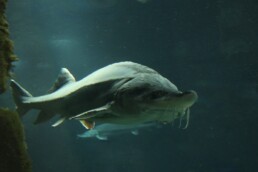White Sturgeon have existed since prehistoric times and late Spring is the perfect time to spy these large but gentle beasts in the Columbia River near Castlegar, British Columbia.
Sturgeon have existed, relatively unchanged, for millions of years. These prehistoric giants are the largest freshwater fish in Canada and the longest lived, reaching ages of 100 or more. The Columbia River population is red-listed (endangered) due to historic overfishing and the construction of dams that alter the river’s natural flow rates and impact the species’ spawning success. Despite this very real risk of extinction, you can still spot these giants in the shallows of the Columbia River around Castlegar.
Also known as:
- Acipenser transmontanus
- wiyaǂ (Ktunaxa)
- xu7i (Secwepemc)
- c̓mtus (Syilx, nsylixcǝn)
- cmtus (Sinixt, snslxcin)
Description:
- Adult sturgeon can weigh as much as 600 kg and grow to 6 metres long!
- Their colouring is light to dark grey or olive on top and white underneath.
- Sturgeon don’t have scales but instead have rows of scutes (bony plates) along the back and sides of the body.
- They have a shark-like tail.
- Sturgeon have a protruding sucker mouth, with four barbels in front that look a bit like whiskers but are really a sensory organ that helps them find food.

Habitat:
- Large rivers with deep, slow moving main channels and areas of swifter water. Require extensive floodplain and side channels at different life stages.
- Habitat requirements are not fully understood for Columbia River sturgeon as the river has changed so much due to the dams.
Viewing Opportunities:
- In the spring, sturgeon can often be spotted below the Robson bridge at the mouth of Pass Creek.
- Keep an eye out for the big shadows of sturgeon in the shallows along the shore of the Columbia River when walking along the Millennium Park pathway.
- Another good spot to check is near the benches at the north end of 3rd Avenue. Polarized sunglasses help.
- Endless Adventure offers sturgeon-viewing paddling excursions on the Columbia River.

Behaviour:
- Feed in deep river-bottom environments. Find food by feel, using sensitive barbels to locate prey and then using suction to suck prey down whole.
- Sturgeon don’t reach sexual maturity until 15 for males and 26 for females. Once mature, female sturgeon only spawn once every 4-10 years.
- Spawning sites tend to be in areas with faster moving currents and rocky substrate. Once the eggs hatch, juvenile sturgeon face a high mortality rate.
- Extremely long lived. Can live to be 100 years or more.
Diet:
- Adult sturgeon eat mainly fish and occasionally, crustaceans and insects
- Juveniles feed on a range of invertebrates and small fishes

Connections:
- Due to historical overfishing and the sturgeon’s endangered status, there has been no commercial or sport fishing here since the 1990s. Indigenous groups in the area also voluntarily stopped their sustenance harvests.
- The plight of the sturgeon is tightly tied to the damming of the Columbia River. It appears that the effect of the dams on river flow, spring flooding, sediment levels, substrate type and turbidity (or clarity) have all impacted sturgeon spawning and rearing habitat to the point of ongoing “recruitment failure” (ie: sturgeon are either not reproducing or juveniles are not surviving).
- Since 2002, a recovery program has been releasing hatchery-raised juvenile sturgeon into the Columbia River and Lower Arrow Lakes to attempt to bolster the wild population.
Cool Facts:
- Sturgeon taste buds are located outside of the mouth! (in the whisker-like barbels)
- Sturgeon swallow prey whole.
- There is also a Kootenay River population that has been isolated from the Columbia River population by the Bonnington Falls since the end of the Pleistocene era 10,000 years ago!
- Sturgeon lay a huge number of eggs. A large female sturgeon can lay up to 4 million eggs!
The goal of wildlife viewing is to safely appreciate the animals in their natural surroundings with minimal impact. To achieve that, here are eight tips:
- Be respectful. Getting too close or staying too long can disrupt feeding and other important behaviours and can cause stress and unpredictable behaviour.
- Give wildlife lots of space. If an animal responds to your presence (eg: looks up, watches you, moves away), you are too close.
- Viewing roadside wildlife can have negative impacts on wildlife by disrupting feeding and leading to habituation to traffic and people. If you spot wildlife while driving, pull over only if it is safe to do so and keep your stop short and sweet.
- Keep dogs on leash and under control at all times to avoid negative encounters
- Carry bear spray and know how to use it.
- Use binoculars and zoom lenses.
- Never feed wildlife.
- Leave no trace. Pack it in, pack it out.
Get To Know The Wildlife Of Castlegar
April 3, 2025
Meet Castlegar Photographer Jamie Isaacs
March 1, 2025
Meet Castlegar Photographer Josh Fogal
March 15, 2024




